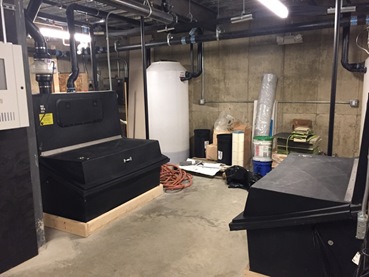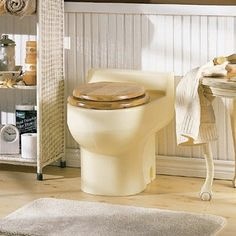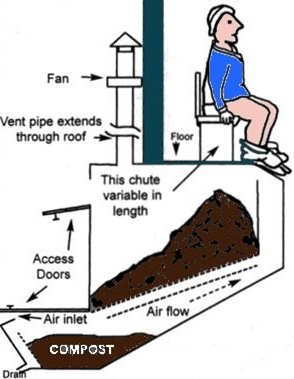by Aubrey Germ, Linnean Solutions — June 17
When we think about waste, we often think about the waste generated through material use, not the nutrient ‘waste’ generated by people and animals. Conversations about waste tend to focus on ways to reduce material waste so we have less product to dispose of and/or more product that becomes reused or recycled. Material waste is easier to handle and control and is certainly less contentious to discuss than other kinds of waste. There certainly is social momentum behind the reduce, reuse, recycle concept when it comes to materialism.
However, when it comes to our human waste, conversations can be bumpy. Unfortunately, we humans can’t simply reduce how much waste our body produces. The answer should be clear: recycle and reuse that… um… stuff.

Figure 1-The two composting chambers in the basement of the Hitchcock Center for the Environment. The facility uses only composting toilets, which reduces water demand by around 65%.
The truth is, our human waste shouldn’t be considered waste at all- it should be thought of as a nutrient. There are many technologies out there that turn human fecal matter into nutrient rich compost, called humus, that can be used as a fertilizer, thus contributing to the ecological cycle of life. For whatever reason, many people are still squeamish about composting toilets, likely imagining the odiferous fragrances emanating from the deep dark hole beneath them. Whatever your thoughts, the technology has improved significantly from the rustic outhouses of yesteryear. Modern composting toilets are so sophisticated that they have been widely adapted in many office buildings and homes. And… it is estimated that a single composting toilet system can save a more than 7,000 gallons of water per person year.
Decomposing the process
For my previous job, I had the pleasure of helping maintain composting toilets at an environmental education center. Though it was not specifically addressed in my job description, I ultimately assumed the role of “Director of Nutrient Services” for the center. I offer will offer thoughts from this experience throughout the rest of this article.
Though every composting toilet differs slightly, the overall features and functions are similar. First off, the only things allowed down the shoot are the three P’s: poop, pee, and [toilet] paper. Anything else will compromise the composting process. A common misstep is when a composting toilet user experiences a moment of uncontrollable curiosity about where their excrement has vanished off to. Before they can even react, they become they eyewitness to their $200 Ray-Bans taking a sacrificial nose dive off their head. There’s no recovering from that one. Don’t say I didn’t warn you.
Gravity guides the three P’s to collect in a composting chamber. The chamber will often contain a composting primer, usually comprised of a mixture of organic material such as sawdust, fungi, or peat moss, as well as a separate section for leachate (a euphemism for urine) to collect and then off-gas the liquid separately through a ventilation system. This is how most of the volume dissipates. Keeping the chamber in a relatively warm, moist setting is also necessary to create a comfy aerobic environment for the decomposition process to occur. Once the compost reaches a temperature of 160 degrees Fahrenheit, all bacteria and viruses will be killed. This happens naturally once the putrefaction process begins and little microbes get in their daily aerobic workout.
There are two main types of composting toilet systems: centralized and self-contained. In a centralized system, the chamber is typically a full story beneath the toilet itself, whereas in a self-contained system, the composting chamber is attached directly to the toilet structure. Centralized systems have larger capacity, are typically more expensive, and are most often used in office or commercial buildings. However, they require less routine maintenance once installed and only need to be emptied about once a year. Popular systems include AlasCan, Clivus Multrum, CTS, EcoTech Carousel, Phoenix and Sun-Mar Centrex and prices range from $1,400 to more than $10,000 depending on the capacity and sophistication of the system. Alternatively, self-contained systems are best for less-intensive use and are common in homes or seasonal-use buildings. These are cheaper to purchase and install, but require more routine maintenance and emptying (maybe once every few months). Nature’s Head, Sun-Mar, Biolet, and Envirolet are example manufacturers of this kind of toilet and prices range from about $750 to $1,500. These systems will eventually pay for themselves after a few years with the money saved on water consumption, as roughly 35% of the water we pay for daily is used for toilet flushing.
Both centralized and self-contained systems require ventilation. Typically, there is an air input vent and fan-powered exhaust system to facilitate airflow for proper oxygenation of the compost and odor elimination. If this all works properly, there will be no smell at all. None! If the composting toilet system doesn’t have an automatic aeration system, the compost needs to be hand-turned. Sometimes sawdust must be added to the carbon-rich refuse to provide the right carbon: nitrogen ratio. A pitchfork with an especially extra super long handle is recommended for hand-churning (speaking from experience here). Over a period ranging from a couple months to a year, the human excrement decomposes into the humus, an odorless humanure, that is less than a third of its original volume. The humus can be extracted through a special door and placed in a state-of-the-art wheelbarrow to be carted off and spread on plants, or added to other compost.
Don’t pollute, contribute!

Figure 3- An example of what an Envirolet waterless composting toilet could look like in your bathroom. Who knew composting feces could be so glamorous?
Composting the pee and poo from me and you can have extensive benefits for green buildings, homes, offices, municipalities, and the world. Primarily, it saves very large amounts of water. Clean, fresh water is a precious and increasingly scarce resource, and the true cost of providing clean water to consumers is not reflected in its price. Older conventional toilets use 3-5 gallons per flush, though it is now federally mandated that new toilets only use 1.6 gallons per flush. Some low-flow toilets can reduce water use to around just 1 gallon, which is an impressive feat and certainly reduces the burden on both septic and already overloaded municipal sewer systems. However, low flush toilets sometimes increase the frequency of clogs, and the addition of water to human waste is precisely what impedes the composting process. Thus, significant energy or extensive filtration is needed to thoroughly treat the blackwater.
Ultimately, composting commodes require no filtration, don’t clog, reduce the carbon footprint of water use and serve to facilitate the healthy cycling of organic nutrients. They cut costs, reduce consumption of resources, reduce the need for commercial fertilizers, and diminish sanitation issues.
Before taking the plunge
There are obviously many benefits to installing composting toilets over traditional flush ones, but here are some things you need to consider before taking the plunge.
As a facilities manager, proper maintenance of these systems is necessary to ensure full decomposition of the refuse and an odor-free process. If the system fails and the problem is not immediately addressed, you might find yourself in a pretty smelly situation. Additionally, the siting and installation of composting toilet systems need to be well thought-out as some of these systems take up more space than your traditional toilet. The amount of electricity needed for operating the exhaust system also needs to be considered as part of the costs for certain models. This can differ based on the size and brand of the system.
The capacity of the system to properly accommodate the intensity of use needs to be carefully designed, as well. Interviewing potential toilet users on frequency use will help you more adequately predict the size of the system necessary. Likewise, you’ll need to do some research on local plumbing and wastewater codes to determine if a composting toilet system is even allowed, or if a special permit is needed, in your area. Certain states, such as Maine, Massachusetts, New Mexico, Minnesota, and Washington, are more accepting of this restroom revolution than others. Lastly, your personal level of comfort in dealing with human waste is very important to consider, as it may eliminate this option entirely. But I’m guessing if you’ve made it this far, you’re comfortable with it.
The bottom line
The benefits of composting systems can certainly outweigh the costs in many ways. A composting commode can save money and resources, can help you and your facility become more sustainable, and can generate nutrient-focused conversations at your facility.
